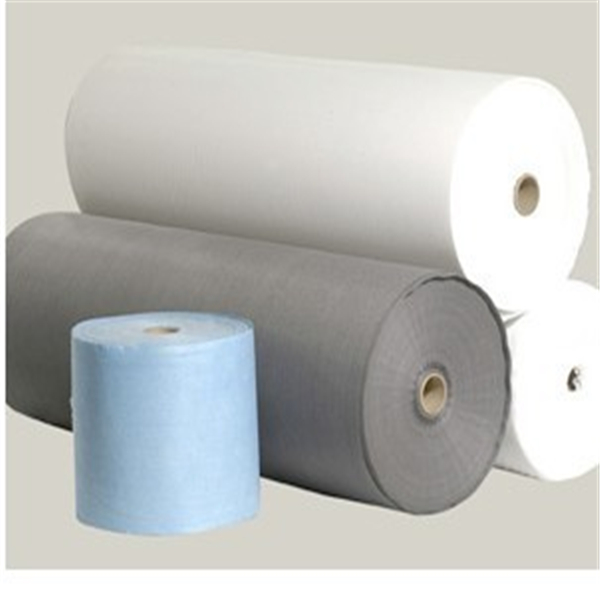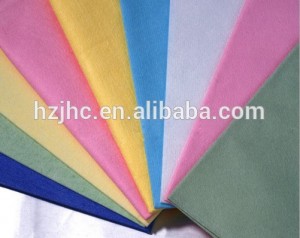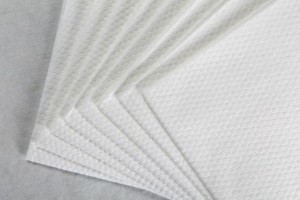Our knowledge of fabric is becoming Less and less now,Especially not familiar with many kinds of fabrics, you certainly don't know spun lace nonwoven, believe that many friends engaged in the production of cloth, for spunlaced nonwoven is familiar, most of the fabrics are made of fiber winding each other together, the spunlaced nonwoven is not exceptional also, However, it is composed of multiple layers of fiber, and it contains a particularly wide range of fiber, the following to understand the spunlaced non-woven supplier's production process is how.
Spunlaced non-weaving process:
A. Fiber raw material → loosen and mix → carding → net laying → drafting → pre-wetting → positive and negative spunking → finishing → drying → winding: water treatment cycle.
B. Fiber raw material → opening and mixing → combing and disorderly mesh →→ pre-wetting → positive and negative spicing → finishing → drying → winding: water treatment cycle.
Different netting methods affect the longitudinal and transverse strength ratio of the final product.
Process A can better adjust the longitudinal and transverse strength ratio of the fiber network, which is suitable for the production of spunlace synthetic leather base cloth. Process B is suitable for the production of spunlaced sanitary materials.
purpose of the pre-wetting
Prehumidification treatment should be carried out to reinforce the forming fiber net with a water inlet.
The purpose of the pre-wetting method is to make the wool fiber net tight, eliminate the air in the fiber net, make the fiber net enter the sponge area, can effectively absorb the energy of water jet, enhance the fiber entanglement effect.
Common prewetting methods:
- Double net clamping type
- Clamping type of roller with hole and transmission curtain
water thorn
Through the pre-wet fiber network into the spunnet area, the water spunhead jet board of the water spout a plurality of micro water, vertical shot to the fiber network.
The water jet causes some fibers of the fiber net to shift, including the vertical movement to the opposite direction of the fiber net. After the water jet passes through the fiber net, it is scattered in different directions by the opposite direction of the curtain or drum.
Due to the double action of water jet impact and recoil water flow, the fibers in the fiber net have displacement, penetration, winding, locking and other phenomena, forming countless flexible tangles, so that the fiber net can be strengthened.
The vertical jet of fiber net structure by water jet can effectively reduce the damage of fiber net structure and make it get the maximum utilization, which is of great significance to improve the properties of spunlaced nonwoven materials.
There are three main methods of spunking reinforcement, namely, flat net spunking, drum spunking, spunking, spunking and so on.
In the reinforcement process of spines, spines are arranged along the circumference of the spines, and the fiber net is adsorbed on the spines to receive the water jet from the spines.
The fiber net is adsorbed on the drum without deviation, which is conducive to high speed production.
At the same time, the fiber net moves on the surface of the spiny area to relax the spiny surface and compress the opposite side, which is conducive to water jet penetration and effective winding of fibers.
The drum is perforated by metal cylinder and equipped with a dehydration device. Compared with the supporting screen curtain reinforced by flat screen spunger method, it has good recoil effect on water flow.
the spunlaced method combined with flat net method, flat net combined with flat net can foster strengths and avoid weaknesses, can play to their advantages, general one, two spunlaced methods for spunlaced method, the third step for flat net method.
The number of spines commonly used in the spines reinforcement process is 7~12, and the common water pressure is 60 ~250 Bar, depending on the quality of fiber network per unit area and production speed. The spines pressure is usually set from low to high to low.
Structure analysis of water jet. According to hydrodynamics, water sprays from the jet hole, which can be called a non-submerged free turbulent jet.
Because of the transverse pulsation of the turbulent jet and the friction resistance of the air convection jet, the water jet from the cluster is gradually transformed into dispersed droplets.
dehydration
The purpose of dehydration is to remove the residual moisture in the fiber net in time, so as not to affect the effect of stabbing the next water needle.
When there is too much water trapped in the fiber net, the water jet energy will be dispersed, which is not conducive to fiber entanglement.
After the spunking process, the moisture in the fiber net is minimized, which is beneficial to reduce the energy consumption of drying.
water treatment and circulation
Spunlace non-woven production process water consumption, output up to 5 tons/day or so, water per hour 150 m3 ~160 m3.
To save water and reduce production costs, the water must be treated and recycled.
(1) Water requirements for spunlaced nonwovens
- High suspended matter will shorten the life of filter bag and filter element.
- Dissolved or colloidal dispersion of organic matter tends to make water turbid and color.This kind of material is easy to deposit in the blowhole, adhere to the fiber, thus affecting the whiteness of the product.
- The invention through the high pressure pump to transport microbial pulp group, will quickly plug the water hole, resulting in a spike pressure suddenly increased, serious shutdown phenomenon.
- Whether anions or cations are dissolved in inorganic salts during spunking, the spunking process will be affected.Calcium and magnesium ions produce dirt on pipes and equipment, and iron, manganese and copper plasmas easily produce colored materials.The production of white sanitary materials should be strictly controlled.When the chlorine content is high, it is easy to cause corrosion of equipment.
Spunlaced non-woven fabric, spunlaced non-woven fabric is composed of a variety of fibers, but this can not be formally called spunlaced non-woven fabric, because it does not spin, but the textile process into automatic spraying.This method combines different fibers and enhances the durability of the fabric, thereby improving its quality.
The above is about spunlaced non-woven fabric process related introduction, if you want to know more about non-woven fabric information, welcome to contact our professional spunlaced non-woven fabric manufacturers.
Video
Learn more about JINHAOCHENG products
Post time: Dec-02-2021



